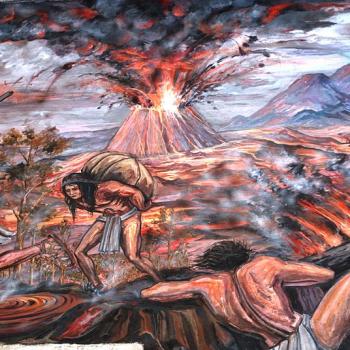
***
This new article, just posted on the website of the Interpreter Foundation, was generously contributed by Jonn Claybaugh, whom I was happy to see at the Foundations’s ninth birthday party on Saturday night:
***
Perhaps you missed these articles from a prior issue of Interpreter: A Journal of Latter-day Saint Faith and Scholarship?
Daniel C. Peterson, “Recent Reflections While Partaking of the Sacrament”
Abstract: Sometimes, obedience to the principles of the Gospel and tending faithfully to our stewardships can seem — and can be — a burden. Moreover, we mortal humans are fallible and weak, and we’re free. Accordingly, I’m convinced that the Father (a supremely masterful strategist and tactician) builds in redundancies so as to ensure that his purposes will be achieved even when his mortal servants falter. At the very heart of his plan, though, there could be no redundancy. Only one person could do what absolutely, desperately, needed to be done.
Matthew L. Bowen, “Shazer: An Etymological Proposal in Narrative Context”
Abstract: In 1 Nephi 16:13–14, Nephi mentions the name Shazer as a toponym the Lehite clan bestowed on a site in western Arabia “four days” journey south-southeast of the valley of Laman. The Lehites used this site as a base camp for a major hunting expedition. A footnote to the first mention of the name Shazer in the 1981 and 2013 Latter-day Saint editions of the Book of Mormon has virtually enshrined “twisting, intertwining” as the presumed meaning of this toponym. However, the structure of Nephi’s text in 1 Nephi 16:12–13 suggests that the name Shazer serves as the bracketing for a chiastic description of the Lehites’ hunting expedition from the site. This chiasm recommends hunting as a possible starting point for seeking a more precise etymology for Shazer, one related to food supply. Consequently, I briefly argue for Shazer as a Semitic word (possibly also a loanword from an Old Arabic dialect) and a close cognate with both Hismaic šaṣar (“young gazelle,” plural šaṣr) and Arabic šaṣara (a type of “gazelle”).
Jeff Lindsay, “A Precious Resource with Some Gaps”
Review of The Joseph Smith Papers, Revelations and Translations, Volume 4: Book of Abraham and Related Manuscripts, eds. Robin Scott Jensen and Brian M. Hauglid (Salt Lake City: Church Historian’s Press, 2018), 381 pages.
Abstract: The publication of high-resolution documents and carefully prepared transcripts related to the origins of the Book of Abraham in The Joseph Smith Papers, Revelations and Translations, Volume 4: Book of Abraham and Related Manuscripts is a remarkable achievement that can help students of Church history and of the Book of Abraham explore many aspects of that volume of scripture for themselves. The book, especially when coupled with the resources and advanced interface of the Joseph Smith Papers website, will provide lasting value for scholars, students, and anyone wishing to better understand the Book of Abraham and its complex origins. However, there are some gaps in the book that must be understood, including a mix of minor errors, questionable assumptions, and a few major problems that can unnecessarily lead readers to question the ancient roots and the divine inspiration behind the Book of Abraham. A future addendum could help resolve many such issues and would be a welcome addition. However, there may be a fundamental flaw in the commentary that tends to align with the way critics of the Church approach the Book of Abraham as a product of Joseph’s environment rather than a text rooted in revelation and antiquity. Sadly, in spite of hundreds of footnotes with extensive references to the research and perspectives of some scholars, this volume tends to exclude a great deal of relevant research provided by some noteworthy scholars. For example, it fails to mention even once the past scholarship of Hugh Nibley on these documents and generally neglects the work of other scholars that can point to the strengths of the Book of Abraham and give tools for coping with the thorny issues. The openness about the conundrums of the Book of Abraham should be encouraged, but it should be balanced with at least an awareness that there are noteworthy positives that readers can weigh against the question marks, and that there are frameworks that can help faithful readers understand how a divinely revealed text can be produced by the same man who wanted to begin learning Egyptian and Hebrew after he had already provided divine translation. Such a balance is needed in a book from the Church dealing with such sensitive issues, where misunderstanding has led some people out of the Church. Sadly, in spite of its many achievements in opening the doors to the documents associated with the Book of Abraham, this book lacks the balance that is needed.
Abstract: In 2013 we published a study examining names from Solomon Spalding’s fictional manuscript, J. R. R. Tolkien’s fictional works, and nineteenth-century US census records. Results showed names created by authors of fiction followed phonemic patterns that differed from those of authentic names from a variety of cultural origins found in the US census. The current study used the same methodology to compare Book of Mormon names to the three name sources in the original study and found that Book of Mormon names seem to have more in common with the patterns found in authentic names than they do with those from fictional works. This is not to say that Book of Mormon names are similar to nineteenth- century names, but rather that they both showed similar patterns when phonotactic probabilities were the common measure. Of course, many more invented names and words from a variety of authors and time periods will need to be analyzed along with many more authentic names across multiple time periods before any reliable conclusions can be drawn. This study was exploratory in nature and conducted to determine if this new line of research merits further study. We concluded it does.
Posted from Cedar City, Utah











